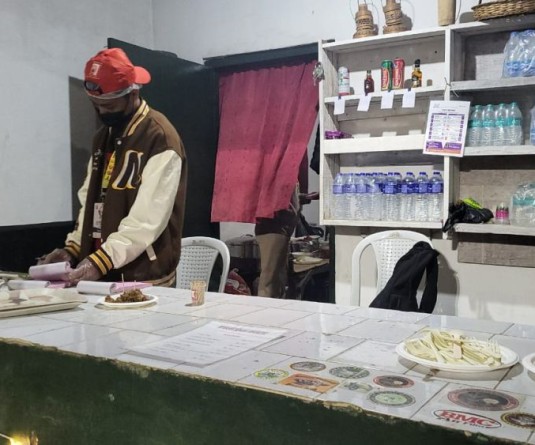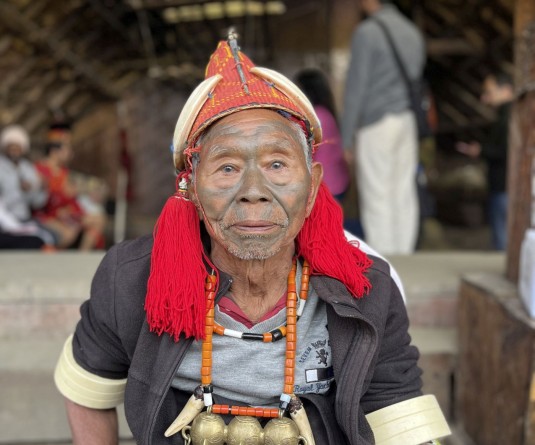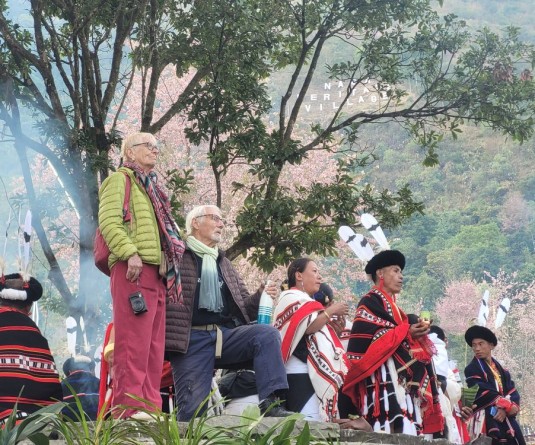.jpg)
.webp)
Imti Longchar
ITC Dan | July 7
It’s 5 am. Khop and his son Ephu pack salt packets and head out to the nearby forest where their Mithuns are grazing. As they sound a rhythmic call, a herd of 15-20 Mithuns, responding to the familiar call, descends down the ridge. Khop feeds them salt from his gunny bag, a treat the semi-bovines eagerly lick away.
For these creatures, salt is more than a dietary necessity; it’s a bond that connects them to their caretakers.
Mithun farmer Kop, who boasts one of the largest herds in the village, explained, “We send our children to school after selling Mithuns. During sickness, we sell these animals to buy medicines. In times of loss, we sacrifice a Mithun to honour the departed.
Mithuns sustain us and it has always helped us through tough times.”
Mithuns, which is also the state animal of Nagaland, are reared in the jungle and have specific salt-feeding places. Khop family owns around 100 Mithuns, although it is hard to keep track since the animals roam the jungles, making it difficult to account for new calves or losses.
Ephu pointed out an essential aspect of Mithun rearing- the need for a couple of males in a group. Without a male leader, the females roam aimlessly. Generations of Ephu’s family—his father, his grandfather—have tended to these majestic creatures. For identification, the Mithuns bears a unique mark on its ear, signifying who the owner (s) is.
Every family has a Mithun
For the people of Pangsha, a village on the Indo-Myanmar border, Mithuns are much more than livestock- it is integral to the community’s identity. Almost every household owns these semi-bovines and it holds a sacred status and plays a pivotal role in major life events- families sell Mithuns to fund education, finance weddings, or cover funeral expenses.
Even the poorest villager participates in Mithun rearing at Pangsha. A unique aspect of Mithun rearing here allows individuals to purchase a leg of live Mithun for Rs 8000 or more, which they can later resell. This system benefits poor families and widows, who use it as a form of investment. However, if the Mithun dies, the investment is lost.
Not just economic assets
Mithuns are more than just economic assets. Historically they are linked to Pangsha’s cultural heritage, symbolizing wealth, status and prosperity.
“Mithun rearing has been important since our forefathers’ time. It has always been beneficial. During sickness, we slay a Mithun, and in the past, when we believed in different gods, we offered it to cure illnesses,” P Shingya, President of Pangsha Public Organization, told The Morung Express, signifying a tradition passed down generations.
With limited options to pursue other economic activities, Mithun rearing has played an essential role for the villager’s survival and financial stability. “This is our only income source. There is not a single family in Pangsha who does not rear Mithuns. Even widows can buy the animal. If buying a whole Mithun is too expensive, which cost up to Rs 1 lakh or more, one can invest in a leg or two,” Shingya stated.
Rearing Mithuns is also a collective endeavour. The Mithun owners check on their animals at least once a week to feed them salt and neighbours often look out for each other’s animals. “Rearing Mithuns resembles community work since all the villagers look after others Mithuns,” Shingya underscored.
Fencing challenges
Rearing Mithuns in the open has significant disadvantages as they are known for destroying crops. This poses a serious problem for the villagers, who rely on both Mithun rearing and farming for sustenance.
To mitigate the damage caused by free-roaming Mithuns, villagers have to fence their agricultural areas, a task which is labour-intensive and costly, Shingya stated. Fencing agricultural area with timber and bamboos has been a practice the village engages in every couple of years when they change the location for cultivation, he added.
Despite their efforts, maintaining the fences is an ongoing struggle, as natural wear and tear, weather conditions necessitate constant repairs.
Although the state government supplied some fencing rolls in 2021 through a Mithun project, it felt short of the requirement for adequately fencing the vast area to be used for Mithun grazing,” Shingya highlighted.
According to estimates, Pangsha village, including New and Old Pangsha and ITC Dan area has more than 2000 Mithuns. Since these animals roam freely, they also cross into Myanmar for grazing.






